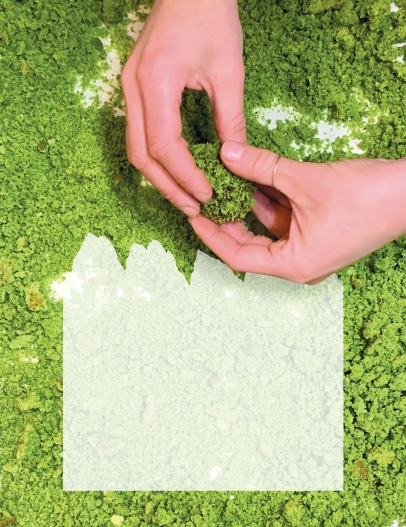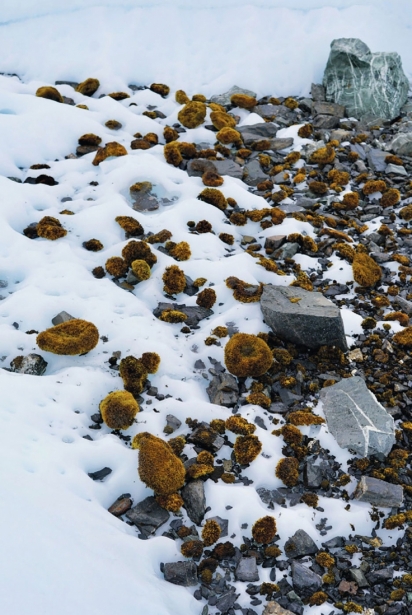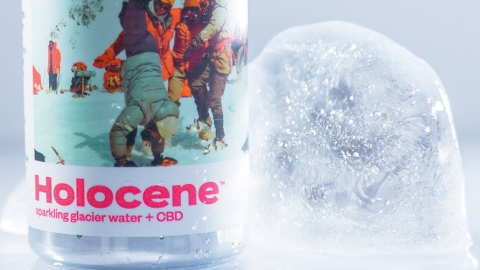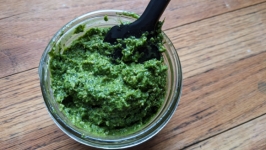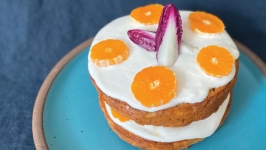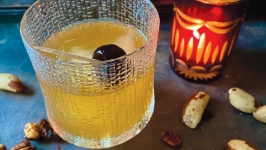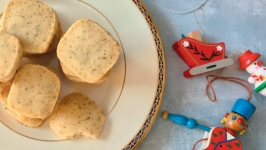Glacier Mice Bites: Biology and Dessert on the Matanuska Glacier
I crested the dented ridge of October ice to find my friend beaming with excitement. Wide-footed in sharp crampons, she sprinted toward a large bowl on the Matanuska Glacier, motioning me to follow as fast as possible. Having beat me there, she recorded the moment I looked into the depression below, burst out laughing, and gleefully shouted, “Oh, my god, look how many truffles there are!”
As a glacier guide in Alaska and a former pastry chef from Brooklyn, it has been the joy of my career to create a way to combine my passions. While leading clients across glaciers and alpine valleys with Seward’s Exit Glacier Guides, I challenged myself to deliver all my interpretive glaciology talks as dessert analogies—making large-scale climate science literally digestible. The process of snow compacting into ice and losing up to 70 percent of its oxygen content is better visualized as a huge wedding cake compressing under its own weight as its buttercream icing gets squished out the sides. A 600-foot-long ice core from the high-altitude plateau of Denali’s Begguya (Mount Hunter) is far more tangible when reduced to a lollipop—peering into the tiny bubbles inside that hold air samples from hundreds or thousands of years before. And while not my original concept, a Snickers bar beautifully explains the cracking of ice (chocolate) on the surface of an ice fall while the layers below (caramel/nougat) bend and stretch around the topography. Throw in a “glacial erratic” peanut boulder for good measure and we’re simultaneously craving something sweet while becoming better educated about the massive climate change indicators in our wild Alaska backyard.
Glaciers have a reputation as barren, frozen wastelands, massively inhospitable and immovable objects with no signs of warmth or life. What I—and many cryo-obsessed others—have found instead is that glaciers hold countless surprises that create opportunities for many different species. In order to share the less familiar and counterintuitive parts of frozen ecosystems, I started crafting desserts that could bring these concepts into homes and hands (and mouths) across the country—sharing the delicious science behind crevasse formation, snow algae, frozen crystals, ice worms, and mysteriously elusive glacier mice.
Glacier mice, as they’re affectionately known, are round or oblong balls of moss—dense, fuzzy, slightly warm, and firmly squishy to the touch. Their combination of mustard yellow specks atop electric lime and pine green all contrast brilliantly with the flat white and dimpled blues of the aged ice underneath. These curious orbs form when a moss spore blows onto a glacier and finds a suitable companion of fine sediment. From there, small particles interact and combine to create an entire micro-environment holding an abundant biome of life on ice. Inside, each moss ball is home to hundreds of tardigrades (or water bears) and other tiny invertebrates like springtails and simple nematode worms. Over time, they accumulate and range in size from the very appropriate equivalents of a small cupcake up to a large dessert plate. If you were to slice a glacier “mouse” in half, the cross-section would show a half-sphere of brown earth covered on all sides by shallow intertwined root systems supporting multiple species of moss coating its surface.
I first learned about glacier mice from a 2020 NPR article featuring Tim Bartholomaus’ work on the Root Glacier in Wrangell-St. Elias National Park. I was instantly hooked. To me, his research photos looked exactly like cake truffles—so I set out to recreate them, a year before I’d ever see one in real life.
When creating place-based desserts, it’s important to pull as much inspiration as possible from our generous environment. Mimicking the deep fragrance of acidic soil and minerality of glacial silt, I made a spin on spicy gingerbread—adding cardamom for notes of floral citrus along with a hearty dose of tricolor pepper and Alaska sea salt. Like glacier ice spilling into a valley, I poured thick dark chocolate ganache over the chewy gingerbread and united the two into a rich, gooey clay-like compost. To create edible moss, I puréed fistfuls of fresh spinach into the milk base for a white cake. I underbaked it, let it cool, and used my hands to crumb the vibrant chartreuse. I gave half of it a second bake to double the texture and shook the two together. To finish, I rolled them into imperfect shapes that would depict movement, coated them in a thin glue of ganache, and then packed the “moss” cake crumb as tightly as possible around each piece. I was thrilled to shape the finished pieces in my hand and tangibly bite into science.
Glaciologist and lifelong Alaskan Aurora Roth has encountered glacier mice in Central/Southeast Alaska and in Iceland. When musing on their place in the greater environment, she noted, “You never see just a single ice mouse. They’re always in little herds. There’s something to be said there about community and sticking together and thriving… even in unexpected places.”
For me, the culinary intersections are exhilarating. Like any good life or delicate pastry recipe, glacier mice confirm that there is power in the careful amassing of small things to create something with newness and depth. The same way we constantly stir a custard or curd to keep it from burning, glacier mice roll every few days—ensuring that none of their mossy sides start to brown. I’m also moved by the spark of contrast. When developing a menu, thoughtful chefs will play with opposing textures, complementary colors, differing temperatures, and distinct shapes. Fragile, sun-warmed, verdant green lumps are in sharp sensory conflict to the durable, smooth, slippery, frigid sapphire of glacier ice—a perfect ecological menu item.In her book Gathering Moss, Robin Wall Kimmerer reminds us that certain mosses can hold 20 to 40 times their weight in water— like our bodies can hold multitudes of grief and memory, like they can swell with infinite joy. Using food to tell stories about the lands we love allows us to intimately interact with our landscapes. Alaska’s foraging culture is a rooted representation of that practice and an enriching reminder of our state’s abundance. However, what’s been most fulfilling to me as an artist, guide, and pastry chef is making sure glaciers get their place at the table too—showcasing Alaska’s 100,000 glaciers as a monumental part of our culinary story.


